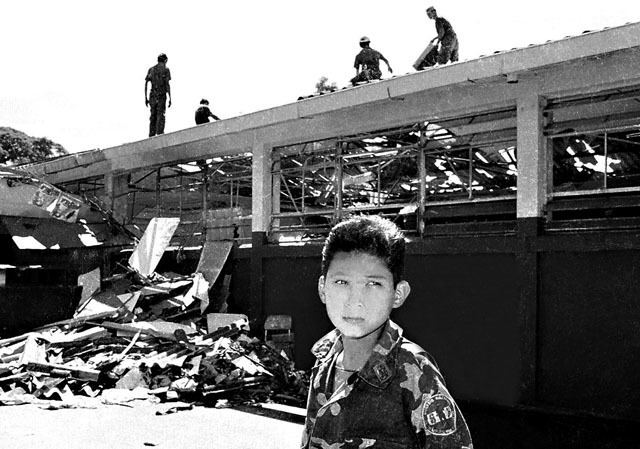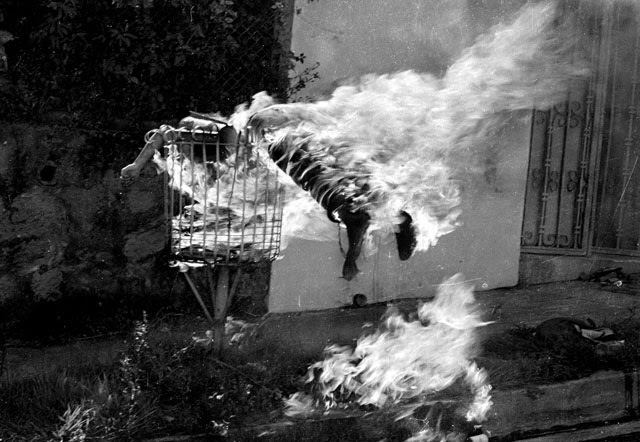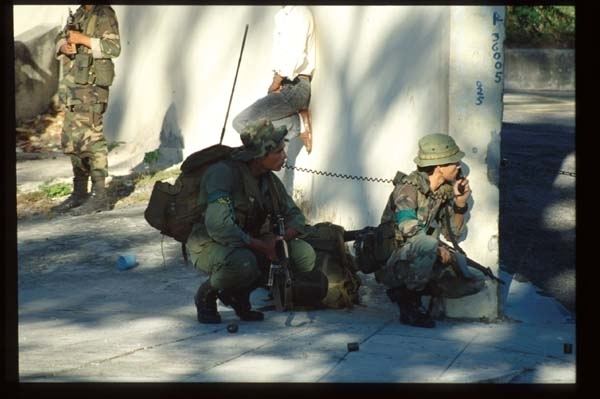Start date November 11, 1989 | ||
 | ||
Ofensiva hasta el tope 11 de nov 1989 muerte de jesuitas
The Ofensiva hasta el tope ("To the top offensive") was the major skirmish of the Salvadoran Civil War. The battle, fought between the Farabundo Martí National Liberation Front (in Spanish: Frente Farabundo Martí para la Liberación Nacional, FMLN) Marxist guerrilla and the Salvadoran government, lasted from November 11 to early December, 1989. Sometimes referred to as “Ofensiva fuera los fascistas. Febe Elizabeth vive”, in honor of an assassinated union leader, it was the most brutal confrontation in the entire conflict, amounting for 17% of the total casualties in ten years of warfare. The extent and consequences of the Ofensiva were determinant of the course the civil war would take in the following two years. The confrontation resulted on several casualties on both armies, as well as many civilians. As a consequence, there was an increased pressure to end the war as it had been shown that neither part could achieve total victory and the losses were too large.
Contents
- Ofensiva hasta el tope 11 de nov 1989 muerte de jesuitas
- Guerra en el salvador ofensiva hasta el tope
- Geography
- Prelude
- The offensive
- Aftermath
- References

Guerra en el salvador ofensiva hasta el tope
Geography

The FMLN launched simultaneous assaults on important military posts in the major cities of San Miguel, Usulután and Zacatecoluca. However, for military, strategic and political reasons, the primary focus of the Ofensiva was the capital city of San Salvador. The city, located in the heart of El Salvador, was easily accessible for the insurgents due to its proximity to the San Salvador Volcano and major guerrilla strongholds of San Jacinto and Guazapa. The FMLN rapidly penetrated into the densely populated urban centers in northern San Salvador: Soyapango, Apopa, Ayutuxtepeque, Cuscatancingo, Ciudad Delgado, Mejicanos and Zacamil. The fighting then spread to rest of the city as insurgent troops were mobilizing in Antiguo Cuscatlán, Huizucar and Santa Tecla, also populous and economically important metropolitan areas to the west of San Salvador. In the climax of the Ofensiva, the rebel forces had penetrated most urban areas of the country for the first time since the beginning of the conflict.
Prelude

The year 1989 was of key importance for the armed conflict in El Salvador. In February of that year, a far-right paramilitary organization known as “Maximiliano Hernández Martínez” placed a bomb near the building of the Salvadoran Workers Union (Spanish: Unión de Trabajadores Salvadoreños). One week later, another attack was orchestrated by right-wing armed groups, this time against the National Worker’s Union Federation (Spanish: Federación Nacional Sindical de Trabajadores Salvadoreños, FENASTRAS), causing the death of ten workers. In the same year, a series of demands from guerrilla towards the government were ignored shortly after right-wing party ARENA’s Alfredo Cristiani had been elected president of the country.

In the midst of violent attacks coming from both involved parties and getting a regional outreach, presidents from Central American countries met in Tela, Honduras to discuss the armed conflict. As a result of this summit, the FMLN was urged to call a ceasefire as stated by the document of Esquipulas II. Meanwhile, in El Salvador, commissions for a peace dialogue were trying to find a peaceful solution to the conflict. A dialogue was held in Mexico on September 13, 1989, resulting in the “Mexico Agreement”, the first formal compromise to negotiate the end of the war. A month later, a new gathering was held in Costa Rica to continue the negotiations. Despite these attempts for peace, the attacks and violence continued to escalate on both sides. In October, 1989, bombs were placed near the house of socialist leader Rubén Zamora and the General Staff of the Salvadoran Army. On October 31, another attack was launched against FENASTRAS, resulting in twenty injured and ten dead unionized workers, including Febe Elizabeth Velázquez, an important figure in the national labor movement. This event led to the FMLN’s retire from the peace negotiations and served as ideological fuel for the Ofensiva, which was already being planned. The international scene also affected sentiment in both sides of the Salvadoran Civil War, especially the FMLN. The Sandinistas were at risk of losing power in Nicaragua, which would mean to lose an important ideological ally and make the smuggling of weapons from the Gulf of Fonseca even harder. The events of the Cold War were also echoing in El Salvador. With the slow decline of communism in the Eastern Block leading the destruction of the Berlin Wall just two days prior to the Ofensiva, the FMLN’s command became demoralized and divided*; some members saw the collapse of their ideology as a reason to find a peaceful and fast solution to the conflict while others became increasingly demotivated at the imminent failure of international communism.
The offensive

Since mid-1989, FMLN commanders Francisco Jovel, Salvador Sánchez Cerén, Eduardo Sancho, Schafik Hándal and Joaquín Villalobos had been meeting in Managua, strategic bastion of the guerrilla's high command, in order to plan what would later become the Ofensiva hasta el tope. Finally, on November 9, 1989, shortly after the FENASTRAS attacks, Villalobos announced an increase in warfare activities and a definite retreat from the dialogues to be held in Caracas at the end of the month. By this time, the Salvadoran Army was already aware of an intended assault on the capital and other cities, but greatly underestimating the magnitude of the attack. At 7:00PM, November 11, 1989, some 2000-3000 armed fighters from the joint guerillas ERP, FPL, FAL, RN and PRTC descended down from the hills that for years had been their territories and into the cities for the first time since the beginning of the war. The guerrilla infiltrated the heavily populated urban centers of northern San Salvador, breaking into civilian houses for protection against the army. The walls that divided the large and crowded apartment complexes were perforated by the guerrilla to make indoor tunnels and provide safe mobilization. The war was also raging in to other major departments, like San Miguel and Santa Ana. The intended targets were various military facilities in the country. The FMLN planned to steal stored weapons and arm the civil population against the government. 48 hours later, the capital had become a battlefield for a large scale insurgent combat. The first target was the army command in Ayutuxtepeque, followed by a series of assaults on military locations in Mejicanos, Ciudad Delgado, Soyapango, Cerro San Jacinto, Zacatecoluca, San Miguel and Usulután. Insurgents also targeted installations of the National Guard, one of the main security forces of the countries. According to retired army official Juan Orlando Zepeda, on the first night of the Ofensiva rebels also attacked the residence houses of president Cristiani, vice-president Merino and Legislative Assembly President Roberto Angulo and several other government officials.
The guerrilla forces took shelter among the civilians in populous colonies like Ciudad Delgado and Soyapango. The original plan was to arm and recruit these civilians and join them in the revolution. However, most of them didn’t and instead fled the colonies occupied by the rebels. Once most civilians had been evacuated, the Air Force bombed the area. This gradual evacuation and the subsequent bombing resulted in heavy casualties for the FMLN. The next day, the government issued a national curfew and media warfare started, as both parties knew the importance of having public opinion on their side. On one hand, the government was censuring all major media. Newspapers were not allowed to discuss military casualties and were urged to show or exaggerate insurgent casualties, so that the population would get the idea of a clear military victory. On the other hand, the guerrilla initiated a heavy propaganda strategy through their clandestine Radio Venceremos.
As the combats progressed in the main urban centers of the country, a military unit of the infamous Batallón Atlacatl broke into José Matías Delgado University (Spanish: Universidad Centroamericana José Matías Delgado, UCA) and executed six Jesuit priests and two domestic employees on November 16, 1989. The UCA martyrs, as they became known, were considered by the Salvadoran right as the “brain of the guerilla” due to their affinity to Liberation Theology and their calls for peace and social justice. Despite the situation, OAS secretary general João Clemente Baena Soares arrived to the country on November 19 to promote peace negotiations. As they advanced through San Salvador, FMLN guerillas eventually reached Hotel Sheraton, where Berna Soares was staying along with several foreigners and five U.S. Marines. The rebels took over the hotel’s VIP tower for several hours holding Baena Soares and the others hostage. Eventually, after an agreement unknown to the public, the hostages were released to the Salvadoran security forces. As a consequence of the Ofensiva, the Salvadoran government broke diplomatic relations with the Nicaraguan government on November 27, claiming involvement in support of the rebels. Two days after, the insurgents assassinated Supreme Court president Francisco José Guerrero and ventured into the affluent neighborhoods Maquilishuat, Campestre, Lomas Verdes and Escalón. The objective was to pressure and destabilize the Army, which would be more hesitant to fight them in these neighborhoods, with important sites like the presidential residency. Finally, by the beginning of December, the Ofensiva was finally ceasing.
Aftermath
The Ofensiva hasta el tope is considered to have speed up the peace negotiations between the government and the FMLN, eventually leading to the peace treaties of Chapultepec that put an end to the 12 year conflict. The government realized the FMLN’s numbers were actually much higher than they had initially estimated and they were getting more and better weaponry through Nicaragua. They knew that, with their current resources, they could never entirely wipe the guerrillas in the mountains and the rural zones they controlled. On the other hand, it was clear that the FMLN would never be able to take over the army in open combat, and that civilians were not willing to join their ranks in an all-out assault. In essence, it was a realization for both parties that they couldn’t win achieve a military victory over the other, and any attempt will only result in more casualties and economic loss. Arguably the most important event of the Ofensiva was the execution of the Jesuit priests in their UCA residence. The event was worldwide recognized as a war crime, and the international community, especially Spain, shifted its attention to El Salvador, for five of the six victims were Spanish citizens. The crime created an outrage that still echos today. Many countries and organizations condemned this issue, and even the United States government began to urge the Salvadoran government for a peaceful end to the conflict. According to José María Tojeira, former rector of the UCA, it was this attack, and not the Ofensiva, which speed up the end of the war. On December 6, colonel René Emilio Ponce, Army Chief of Staff emitted a statement where he established the FMLN casualties in 1902 dead and 1109 injured and 446 dead and 1228 injured for the armed forces. The Ministry of Planning established numbers of 4499 victims between November 11 and December 12, with 1526 FMLN fighters, 428 military and 64 civilians. Economic damages were counted in 597 million colones, with industry and commerce sectors being the most affected. A total of 3048 homes were destroyed or damaged in the areas of Mejicanos, Ciudad Delgado, Cuscatancingo, Apopa, Soyapango and San Salvador.
